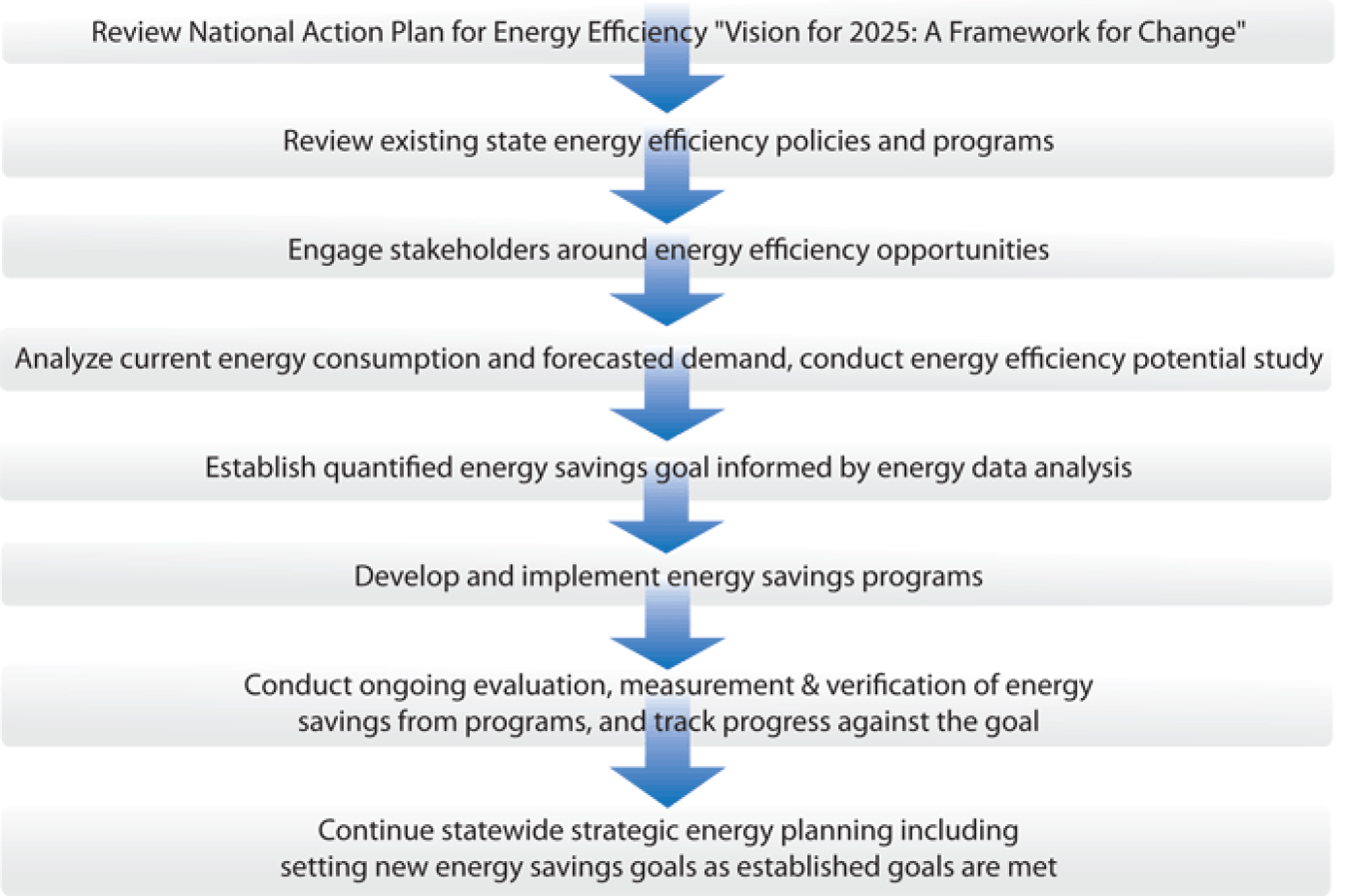During Fiscal Years 2010-2013, the U.S. Department of Energy's (DOE) State Energy Program (SEP) competitively awarded a total of $4.05 million to assist states in developing policy and program frameworks that supported cost-effective energy efficiency initiatives designed to increase annual statewide energy savings.
States with electricity savings of less than 0.5% were encouraged to establish an energy savings goal of at least 1% of electricity sales. States worked toward achieving their goal through the adoption of energy efficiency policies and the implementation of utility programs designed to reduce electricity demand.
States that had moderate to significant current electricity savings were encouraged to develop strategies that could help them exceed existing electricity savings by 1% annually. These states developed a variety of strategies to bolster energy efficiency programs and realize the full potential for greater energy efficiency in the state, sharing their lessons learned with DOE for other states and government entities to leverage.
States supported with this award achieved their goals through a collaborative and inclusive stakeholder process, and built on the foundation of the National Action Plan for Energy Efficiency Vision for 2025: A Framework for Change (see figure 1 below, which outlines the process).

State Goals and Activities Under the Award
The states awarded SEP competitive funding assistance for stimulating energy efficiency action to:
- Alaska Energy Authority (AEA) set an energy savings target of 15% relative to 2010 residential and commercial energy use levels by 2020. AEA is working toward achieving this goal by improving the delivery and effectiveness of public outreach and education. AEA's Recommendations for Alaska Energy Efficiency and Conservation Public Education and Outreach informed the design of a number of targeted energy efficiency programs that are being delivered in a variety of rural and urban Alaskan communities.
- Arkansas Energy Office (AEO), in partnership with the Southeast Energy Efficiency Alliance, hopes to expand its 2010 Energy Efficiency Resource Standard targets (the first in the southeast) to be more competitive. From 2010 – 2013, Arkansas successfully met its goals during the three-year efficiency target cycle and is ramping up for its second cycle of efficiency targets, which require incrementally higher savings than the first-round targets. With the appropriate research and support, along with increased stakeholder collaboration, AEO is confident that the state will find effective solutions to meet and exceed the proposed savings requirements.
- Kentucky Department of Energy Development and Independence (KY DEDI) is working toward saving 1% electricity annually by 2014, with plans to ramp up to 12% annual electric savings by 2025. Through relationship and consensus building with stakeholders, KY DEDI has stimulated statewide energy efficiency efforts and participation. KY DEDI secured voluntary agreements with Kentucky's largest electric utilities to report energy savings data annually. With involvement and input from stakeholders, KY DEDI completed the comprehensive Kentucky Energy Efficiency Action Plan in the spring of 2013.
- Mississippi Development Authority (MDA) in partnership with the Southeast Energy Efficiency Alliance, is working to achieve 1% savings over the next three to five years through energy efficiency programs implemented by utilities or other program administrators. With the advancement of Governor Bryant's Energy Works: Mississippi's Energy Roadmap and the adoption of Mississippi’s first energy efficiency rules in 2013 , which includes Chapter 29 §106 Cost Recovery—a Mississippi Public Service Commission commitment to an energy savings target—Mississippi now has the opportunity to leverage this rare and truly remarkable momentum. By providing technical resources and added human capital, MDA can facilitate a robust conversation among a variety of stakeholders, working to find innovative solutions and approaches that will forge a path to a statewide energy savings goal of at least 1%.
- New Hampshire Office of Energy and Planning (OEP) is working with key partners and stakeholders to assess the economic feasibility of increasing investment in energy efficiency through adoption of an EERS or other policy mechanisms. The project team will explore how best to establish a specific and measurable goal or set of goals for the state of New Hampshire for energy efficiency, and will lay the groundwork for enacting the policy to adopt those goals. This project builds on work done under a comprehensive study that was completed by an independent consultant in conjunction with the state's Energy Efficiency and Sustainable Energy Board, which recommended that New Hampshire develop and establish an EERS or other mechanism to set specific energy efficiency goals.
- Texas State Energy Conservation Office (TX SECO) is working to enhance energy efficiency program offerings in areas of the state served by more than 100 publically owned utilities. TX SECO has focused their award on support to utilities that do not fall under TX Energy Efficiency Resource Standards (EERS). TX SECO developed an Energy Efficiency Best Practices Guide, and a Budget and Savings Estimate Calculator, and is working with municipal utilities to help accelerate deployment of energy efficiency programs for their residential and commercial customers.
- Washington Department of Commerce's State Energy Office (WA SEO) is aiming to achieve an additional 1% savings in electricity sales beyond their current savings rate. WA SEO is working to enhance implementation of the state's voter-enacted EERS by identifying and reducing specific market barriers to EERS compliance, and through improved planning and coordination between private and public utilities.
